Chapter 4: Investment appraisal – further aspects of discounted cash flows
Chapter learning objectives
Upon completion of this chapter you will be able to:
- explain the impact of inflation on interest rates and define and distinguish between real and nominal (money) interest rates
- explain the difference between the real terms and nominal terms approaches to investment appraisal
- use the nominal (money) terms approach to appraise an investment
- use the real terms approach to appraise an investment
- explain the impact of tax on DCF appraisals
- calculate the tax cash flows associated with capital allowances and incorporate them into net present values (NPV) calculations
- calculate the tax cash flows associated with taxable profits and incorporate them into NPV calculations
- explain the impact of working capital on an NPV calculation and incorporate working capital flows into NPV calculations.
1 The impact of inflation on interest rates
 Inflation is a general increase in prices leading to a general decline in the real value of money.
Inflation is a general increase in prices leading to a general decline in the real value of money.
In times of inflation, the fund providers will require a return made up of two elements:
- real return for the use of their funds (i.e. the return they would want if there were no inflation in the economy)
- additional return to compensate for inflation.
The overall required return is called the money or nominal rate of return.
 The real and money (nominal) returns are linked by the formula:
The real and money (nominal) returns are linked by the formula:
(1 + i) = (1 + r)(1 + h)
where
i = money rate
r = real rate
h = inflation

 Illustration of relationship between inflation and interest rates
Illustration of relationship between inflation and interest rates
An investor is prepared to invest $100 for one year.
He requires a real return of 10% pa.
In addition, he requires compensation for loss of purchasing power resulting from inflation which is currently running at 5% pa.
What money rate of return will he require?
Solution
Just to compensate for inflation, his money needs to increase by 5%, to $100 × 1.05 = $105.
To give a real return on top of this, it must further increase by 10%, to $105 × 1.1 = $115.50.
Thus his money must increase overall by 1.05 × 1.1 =1.155, i.e. by 15.5%.
So the investor's actual required return is 15.5%.


 Test your understanding 1 – Money and real returns
Test your understanding 1 – Money and real returns
$1,000 is invested in an account that pays 10% interest pa. Inflation is currently 7% pa.
Find the real return on the investment.


 Test your understanding 2 – Money and real returns
Test your understanding 2 – Money and real returns
If the real rate of interest is 8% and the rate ofinflation is 5%, what should the money rate of interest be?

2 The impact of inflation on cash flows
 Where cash flows have not been increased for expected inflation they are known as current cash flows, or real cash flows.
Where cash flows have not been increased for expected inflation they are known as current cash flows, or real cash flows.
 Where cash flows have been increased to take account of expected inflation they are known as money cash flows, or nominal cash flows. Remember, if they do take inflation into account, they represent expected flows of money, hence the term 'money cash flows'.
Where cash flows have been increased to take account of expected inflation they are known as money cash flows, or nominal cash flows. Remember, if they do take inflation into account, they represent expected flows of money, hence the term 'money cash flows'.
You can assume that cash flows you are given in the exam are the money cash flows unless told otherwise.
If the examiner specifies that the cash flows are in current termsyou will generally need to put these in money terms before you candiscount them (although see "other methods of dealing with inflation"below).
- For example if the question tells you that sales for the next 3 years are $100 in current terms but are expected to inflate by 10%, then what he actually means is that the sales will be:
Make sure you read the question carefully. Sometimes you will be given the cash flows in Year 1 terms with subsequent inflation.
- For example if the question says "Sales will be $100 in the first year, but are they going to inflate by 10% for the next two years", then the sales will be:
The impact of inflation can be dealt with in two different ways - both methods give the same NPV.

 Test your understanding 3 – Money and real methods
Test your understanding 3 – Money and real methods
Storm Co is evaluating Project X, which requires an initialinvestment of $50,000. Expected net cash flows are $20,000 per annum forfour years at today's prices. However these are expected to rise by5.5% pa because of inflation. The firm's money cost of capital is 15%.
Find the NPV by:
(a)discounting money cash flows
(b)discounting real cash flows.


 Test your understanding 4 – Money and real methods
Test your understanding 4 – Money and real methods
A project has the following cash flows before allowing for inflation, i.e. they are stated at their T0 values.
The company's money discount rate is 15.5%. The general rate of inflation is expected to remain constant at 5%.
Evaluate the project in terms of:
(a)real cash flows and real discount rates
(b)money cash flows and money discount rates.

3 Specific and general inflation rates
The TYUs given above had all cash flows inflating at the generalrate of inflation. In practice, inflation does not affect all costs tothe same extent. In some investment appraisal questions you may be giveninformation on more than one inflation rate. In these situations youwill have information on both specific inflation rates and generalinflation rates.
In situations where you are given a number of specific inflation rates, the real method outlined above cannot be used.
The following gives a useful summary of how to approach examination questions.
If a question contains both tax and inflation, it is advisable to use the money method.

 Specific and general inflation rates
Specific and general inflation rates
If there is one rate of inflation in the question both the real andmoney method will give the same answer. However it is easier to adjustone discount rate, rather than all the cash flows over a number ofyears. This is particularly true where the cash flows are annuities. Thereal method is the only possible method where they are perpetuities.
Although it is theoretically possible to use the real method inquestions incorporating tax, it is extremely complex. It is thereforemuch safer (and easier) to use the money/nominal method in all questionswhere tax is taken into account.
To use the real method when cash flows inflate at different rates(specific rates) is extremely complex and would involve a lot ofcalculations. It is therefore advisable to always use the money methodin these situations. This involves:
- inflating the cash flows at their specific inflation rates
- discounting using the money rate
Very often the money rate will not be given in the question butwill need to be calculated. This should be done using the real rate andthe general inflation rate.

 In the examination, for a short life project, with cash flows inflatingat different rates, it is best to set the NPV calculation out with thecash flows down the side and the time across the top.
In the examination, for a short life project, with cash flows inflatingat different rates, it is best to set the NPV calculation out with thecash flows down the side and the time across the top.

 Test your understanding 5 – General and specific inflation rates
Test your understanding 5 – General and specific inflation rates
A company is considering a cost-saving project. This involvespurchasing a machine costing $7,000, which will result in annual savings(in real terms) on wage costs of $1,000 and on material costs of $400.
The following forecasts are made of the rates of inflation each year for the next five years:

The cost of capital of the company, in real terms, is 8.5%.
Evaluate the project, assuming that the machine has a life of five years and no scrap value.

4 Dealing with tax in NPV calculations
Since most companies pay tax, the impact of corporation tax must be considered in any investment appraisal.

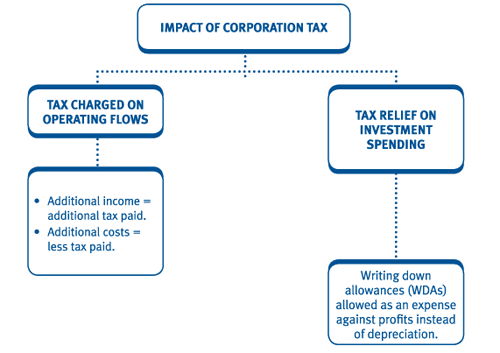
The impact of taxation on cash flows
Corporation tax charged on a company’s profits is a relevant cashflow for NPV purposes. It is assumed, unless otherwise stated in thequestion, that:
- operating cash inflows will be taxed at the corporation tax rate
- operating cash outflows will be tax deductible and attract tax relief at the corporation tax rate
- investment spending attracts capital allowances (or writing down allowances (WDAs)) which get tax relief
- the company is earning net taxable profits overall (this avoids any issues of carrying losses forwards to reduce future taxation).
- tax is paid one year after the related operating cash flow is earned (unless told otherwise)

 The impact of taxation on cash flows
The impact of taxation on cash flows
Taxation has the following effects on an investment appraisal problem:
- Project cash flows will give rise to taxation which itself has an impact on project appraisal. Normally we assume that tax paid on operating flows is due one year after the related cash flow. However, it is possible for alternative assumptions to be made and so you should read any examination question carefully to ascertain precisely what assumptions are made in the question.
- Organisations benefit from being able to claim capital allowances – a tax deductible alternative to depreciation. The effect of these is to reduce the amount of tax that organisations are required to pay. Again it is important to read any examination question carefully in order to identify what treatment is expected by the examiner. A common assumption is that WDAs at 25% pa are receivable.
Note that the WDAs are not cash flows and to calculate thetax impact we have to multiply each year's WDA by the corporation taxrate. The effect of a WDA is on the amount of tax payable, which is therelevant cash flow.
In dealing with these tax effects it is always assumed that where atax loss arises from the project, there are sufficient taxable profitselsewhere in the organisation to allow the loss to reduce any relevant(subsequent) tax payment (and it may therefore be treated as a cashinflow) and that the company has sufficient taxable profits to obtainfull benefit from capital allowances.
In practice, the effects of taxation are complex, and are influenced by a number of factors including the following:
- the taxable profits and tax rate
- the company's accounting period and tax payment dates
- capital allowances
- losses available for set-off
but many of these issues are ignored or simplified for the purposes of NPV investment appraisal.

Capital allowances/WDAs
For tax purposes, a business may not deduct the cost of an assetfrom its profits as depreciation (in the way it does for financialaccounting purposes).
Instead the cost must be deducted from taxable profits in the formof 'capital allowances' or WDAs. The basic rules are as follows:
- WDAs are calculated based on the written down value of the assets (this will either be on a reducing balance or straight line basis – read the question carefully)
- the total WDAs given over the life of an asset equate to its fall in value over the period (i.e. the cost less any scrap proceeds)
- WDAs are claimed as early as possible
- WDAs are given for every year of ownership except the year of disposal
- in the year of sale or scrap a balancing allowance (BA) or balancing charge arises (BC).
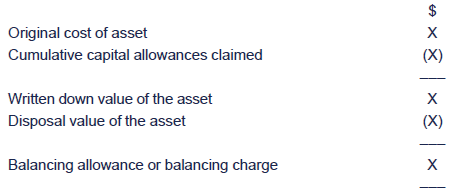
Note: As financial management terms continue theirinternationalisation, the term 'capital allowance' or 'writing downallowance' is sometimes being replaced by 'tax allowable depreciation'.All three terms can be used interchangeably.

 Capital allowances
Capital allowances
If a business buys a capital asset in one year and sells it severalyears later, the total tax relief it will receive is the tax on thecost of the asset less its eventual disposal value.
For example, if a business buys equipment for $100,000 in Year 0and disposes of it in Year 5 for $20,000, it will receive tax relief onthe net cost of $80,000. If the rate of corporation tax is 30%, thereduction in tax payments over the five years would be 30% × $80,000 =$24,000.
Balancing allowances are given as a final deduction to ensure thefull fall in value has been allowed. Balancing charges occur where thetotal WDAs claimed exceed the fall in value of the asset. The excessclaimed is treated as a taxable amount in the year of disposal.


 Test your understanding 6 – Balancing allowance or charge
Test your understanding 6 – Balancing allowance or charge
An asset is bought for $10,000 and will be used on a project forfour years after which it will be disposed of. Tax is payable at 30%,one year in arrears, and capital allowances are available at 25%reducing balance.
Required:
(a)Calculate the WDA and hence the tax savings for each year if the proceeds on disposal of the asset are $2,500.
(b)How would your answer change if the asset was sold for $5,000?

 For tax purposes care must be taken to identify the exact time of asset purchase.
For tax purposes care must be taken to identify the exact time of asset purchase.

- Assets are assumed to be bought at T0.
- This could be the very end of an accounting period (e.g. 31/12/X1) or the start of another (e.g.1/1/X2).
- There is no distinction between these dates for discounting, but there is for tax.
Asset bought at the start of an accounting period:
Asset bought at the end of an accounting period:

 Timing of asset purchase and sale
Timing of asset purchase and sale
Although the total value of WDAs will not alter, the timing of theasset purchase affects how much of the total fall in value is claimed ineach tax year. Because of the time value of money, the later thedeductions are taken, and the corresponding tax relief claimed, the lessworthwhile the WDAs will be.
- If an asset is bought at T0 on 1/1/X2, the first year of ownership is the period 1/1/X2 – 31/12/X2, and the first WDA deduction will be set off against profits earned in that period. Since for NPV purposes cash flows are deemed to occur at year end, the WDA deduction will be claimed at T1. Corresponding tax relief will therefore occur one year later at T2.
- However, if the asset is bought, still at T0, but at the end of an accounting period, e.g. on 31/12/X1, the first WDA will be allowed for set-off against profits earned in the accounting period 1/1/X1 – 31/12/X1 (i.e. a period earlier that in the past example) since this is now the first year of ownership, even though the asset was owned for only one day of the year. This means the WDA is claimed at T0, at the same time as the purchase. The corresponding tax relief will therefore occur a year earlier than before at T1.


 Test your understanding 7 – NPV including tax
Test your understanding 7 – NPV including tax
Using the same information as provided in the previous test yourunderstanding. An asset is bought for $10,000 and will be used on aproject for four years after which it will be disposed of for $2,500.Tax is payable at 30%, one year in arrears, and capital allowances areavailable at 25% reducing balance.
Required:
The answer to the previous test your understanding assumed that theasset was bought on the first day of an accounting period (T0) and thatthe first writing down allowance was awarded at the end of theaccounting period (at T1) (Note: this should be the standard defaultposition if no information is provided in the question).
How would this answer change if you were told the asset was bought on the last day of the previous accounting period?


 Test your understanding 8 – NPV including tax
Test your understanding 8 – NPV including tax
A company buys an asset on the last day of the accounting periodfor $26,000. It will be used on a project for three years after which itwill be disposed of on the final day of year 3. Tax is payable at 30%one year in arrears, and capital allowances are available at 25%reducing balance.
(a)Calculate the WDA and hence the tax savings for each year if the proceeds on disposal of the asset are $12,500.
(b)If net trading income from the project is $16,000 pa and the cost of capital is 8% calculate the NPV of the project.
(c)How would your answer change if the asset was bought on the first day of the accounting period?

5 Incorporating working capital
Investment in a new project often requires an additional investmentin working capital, i.e. the difference between short-term assets andliabilities.
 The treatment of working capital is as follows:
The treatment of working capital is as follows:
- initial investment is a cost at the start of the project
- if the investment is increased during the project, the increase is a relevant cash outflow
- at the end of the project all the working capital is 'released' and treated as a cash inflow.
To calculate the working capital cash flows you should:
Step 1: Calculate the absolute amounts of working capital needed in each period
Step 2: Work out the incremental cash flows required each year

 Test your understanding 9 – Working capital
Test your understanding 9 – Working capital
A company expects sales for a new project to be $225,000 in thefirst year growing at 5% pa. The project is expected to last for 4years. Working capital equal to 10% of annual sales is required andneeds to be in place at the start of each year.
Calculate the working capital flows for incorporation into the NPV calculation.

If you have a question including both working capital andinflation, you should always adopt the money method (inflating the cashflows). Calculate the actual money amount of the factor on which workingcapital is dependent (often sales or contribution) before calculatingthe working capital requirements.

 Test your understanding 10 – Working capital
Test your understanding 10 – Working capital
A company anticipates sales for the latest venture to be 100,000units per year. The selling price is expected to be $3 per unit in thefirst year, inflating by 8% pa over the three-year life of the project.Working capital equal to 10% of annual sales is required and needs to bein place at the start of each year.
Calculate the working capital flows.

6 Laying out long NPV questions
For the majority of investment appraisal questions, the following pro-forma is recommended:
7 Dealing with questions with both tax and inflation.
Combining tax and inflation in the same question does not make it any more difficult than keeping them separate.
Questions with both tax and inflation are best tackled using the money method.
- Inflate costs and revenues, where necessary, before determining their tax implications.
- Ensure that the cost and disposal values have been inflated (if necessary) before calculating WDAs.
- Always calculate working capital on these inflated figures, unless given.
- Use a post-tax money discount rate.

 Test your understanding 11 – NPV with tax and inflation
Test your understanding 11 – NPV with tax and inflation
Ackbono Co is considering a potential project with the following forecasts:

The initial investment will be made on the first day of the new accounting period.
The selling price per unit is expected to be $100 and the variablecost $30 per unit. Both of these figures are given in today's terms.
Tax is paid at 30%, one year after the accounting period concerned.
Working capital will be required equal to 10% of annual sales. This will need to be in place at the start of each year.
WDA's are available at 25% reducing balance.
The company has a real required rate of return of 6.8%.
General inflation is predicted to be 3% pa but the selling price is expected to inflate at 4% and variable costs by 5% pa
Determine the NPV of the project.
N.B. work in $ millions and round all numbers to the nearest whole million.

Chapter summary
Test your understanding answers

 Test your understanding 1 – Money and real returns
Test your understanding 1 – Money and real returns
Real return = $1,000 × 1.1/1.07 = $1.028. A return of 2.8%.


 Test your understanding 2 – Money and real returns
Test your understanding 2 – Money and real returns
(1 + i) = (1 + r)(1 + h) = 1.08 × 1.05 = 1.134
Money rate (i) = 13.4%.


 Test your understanding 3 – Money and real methods
Test your understanding 3 – Money and real methods
Discounting the money cash flows at the money rate – the money method
Discounting money cash flow at the money rate: The cash flows attoday's prices are inflated by 5.5% for every year to take account ofinflation and convert them into money flows. They are then discountedusing the money cost of capital.
The money cash flows are therefore:
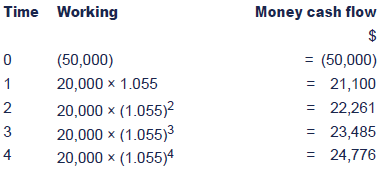
Note: The question simply refers to the 'firm's cost ofcapital'. You can assume this is the money rate – if you are given areal rate the examiner will always specify.
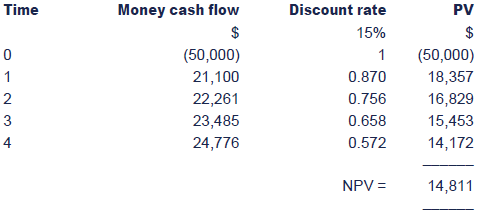
Discounting the real cash flows at the real rate – the real method.
Calculate the real rate by removing the general inflation from the money cost of capital:

The real rate can now be applied to the real flows without any further adjustments.

Note: Differences due to rounding.


 Test your understanding 4 – Money and real methods
Test your understanding 4 – Money and real methods
(a)Real cash flows and real discount rates
Discount rate as per the question of 15.5% includesinvestor's/lender's inflation expectation of 5%. Hence 'real' discountrate, r, is given by:
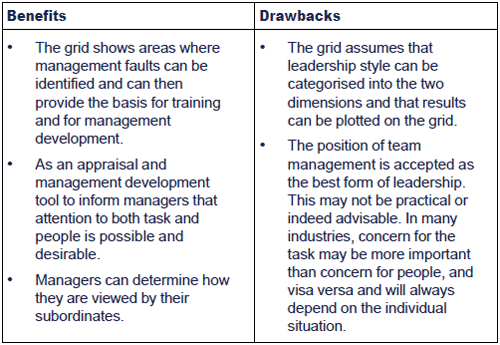
(b)Money cash flows and money discount rates
The discount rate as per the question of 15.5% is the money discount rate.
To convert real cash flows into money flows they will need to be increased by 5% each year from year 0, to allow for inflation.
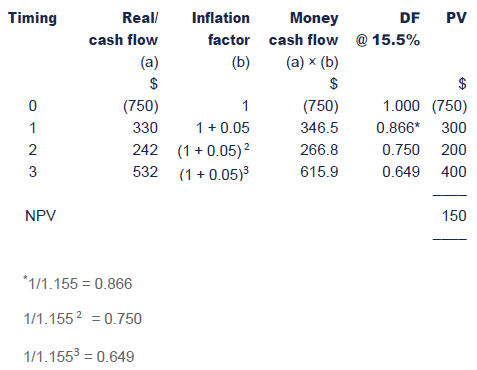
Note: that either approach yields identical conclusions (allowing for rounding).


 Test your understanding 5 – General and specific inflation rates
Test your understanding 5 – General and specific inflation rates
Since the question contains both specific and general inflation rates, the money method should be used
Step 1
The money method needs to be calculated using the informationprovided on the real rate of return and the general rate of inflation
(1 + i) = (1 + r)(1 + h)
(1 + i) = (1.085)(1.06)
i = 15%
Step 2
Inflate the cash flows using the specific inflation rates and discount using the money rate calculated above.
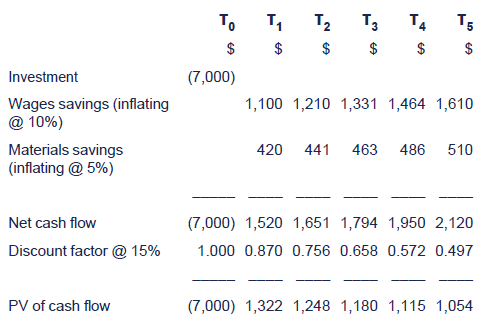
Therefore NPV = $(1,081) which suggests the project is not worthwhile.


 Test your understanding 6 – Balancing allowance or charge
Test your understanding 6 – Balancing allowance or charge
(a)

Note:
- total WDAs = 2,500 + 1,875 + 1,406 + 1,719 = 7,500 = fall in value of the asset
- total tax relief = 750 + 563 + 422 + 516 = 2251 ≈ 7,500 × 30% (WDAs x tax rate)
(b)If the scrap proceeds had been$5,000, there would be a balancing charge in T4 of $5,000 – $4,219 =$781 and additional tax of $234 ($781 × 30%) would be payable in T5.
Note:
- total WDAs = 2,500 + 1,875 + 1,406 – 781= 5,000 = fall in value of the asset
- total tax relief = 750 + 563 + 422 – 234 = 1,501 ≈ 5,000 × 30% (WDAs x tax rate)


 Test your understanding 7 – NPV including tax
Test your understanding 7 – NPV including tax
The asset is still bought at time T0 but falls into the previousaccounting period for tax purposes. This means that the first writingdown allowance is also received at T0.
The overall value of WDAs claimed and therefore the total taxsaving remains unchanged, but the timing and amount of the individualamounts will alter. Because of the time value of money, this will impactthe final NPV.

Note:
- total WDAs = 2,500 + 1,875 + 1,406 + 1,055 + 664 = 7,500 = fall in value of the asset
- total tax relief = 750 + 563 + 422 + 317 + 199 = 2251 ≈ 7,500 x 30% (WDAs x tax rate)


 Test your understanding 8 – NPV including tax
Test your understanding 8 – NPV including tax
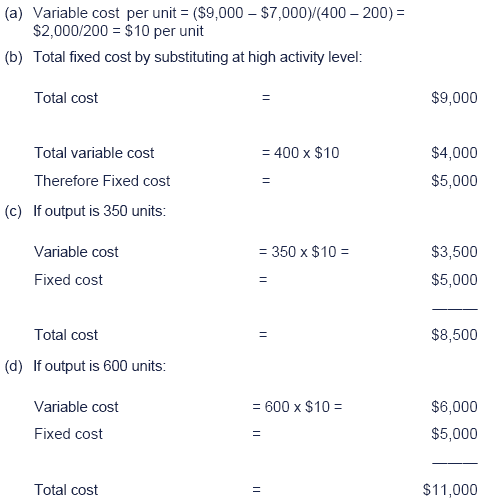

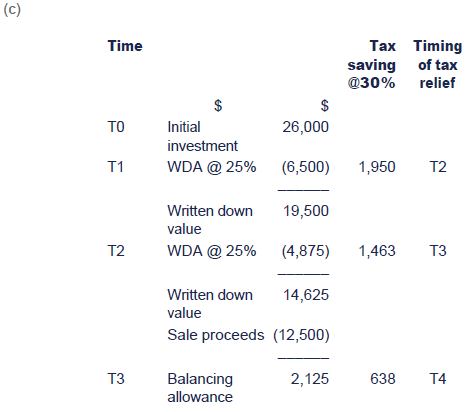

The NPV is lower as a result of the purchase being delayed.


 Test your understanding 9 – Working capital
Test your understanding 9 – Working capital
Step 1: Calculate the absolute amounts of working capital needed over the project:

Step 2: Work out the incremental investment required each year (remember that the full investment is released at the end of the project):



 Test your understanding 10 – Working capital
Test your understanding 10 – Working capital
Step 1: Calculate the absolute amounts of working capital needed over the project:
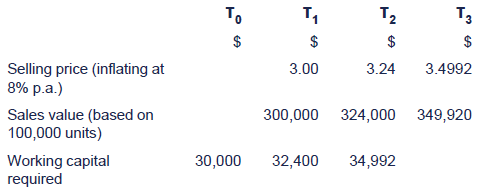
Step 2: Work out the incremental investment required each year,remembering to release all the working capital at the end of the project



 Test your understanding 11 – NPV with tax and inflation
Test your understanding 11 – NPV with tax and inflation
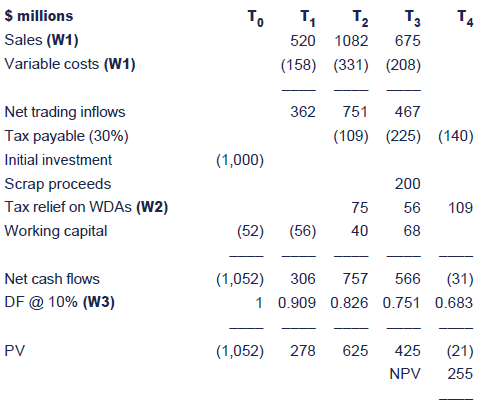
W1: revenue and costs
Revenue and costs need to be expressed in money terms.
e.g. revenue at T2 = $10m × 100 × (1.04)2 = $1,081.6m.
W2: WDAs
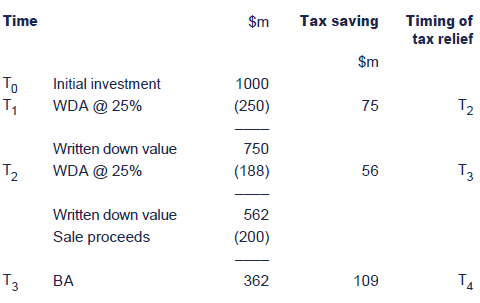
W3: Working capital requirements
Step 1: Calculate the absolute amounts of working capital needed over the project:

Step 2: Work out the incremental investment required each year,remembering to release all the working capital at the end of the project

W4:Discount rate
(1+i) = (1+r) × (1+h) = 1.068 × 1.03 = 1.10, giving a money rate (i) = 10%.

|
Created at 5/24/2012 4:10 PM by System Account
(GMT) Greenwich Mean Time : Dublin, Edinburgh, Lisbon, London
|
Last modified at 5/25/2012 12:54 PM by System Account
(GMT) Greenwich Mean Time : Dublin, Edinburgh, Lisbon, London
|
|
|
|
 |
Rating
:
|
 Ratings & Comments
(Click the stars to rate the page) Ratings & Comments
(Click the stars to rate the page)
|
 |
Tags:
|
|
|
|
|